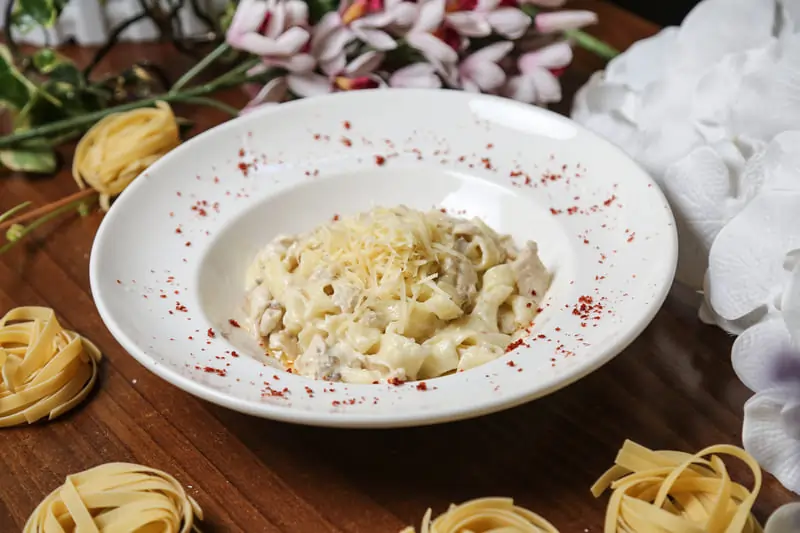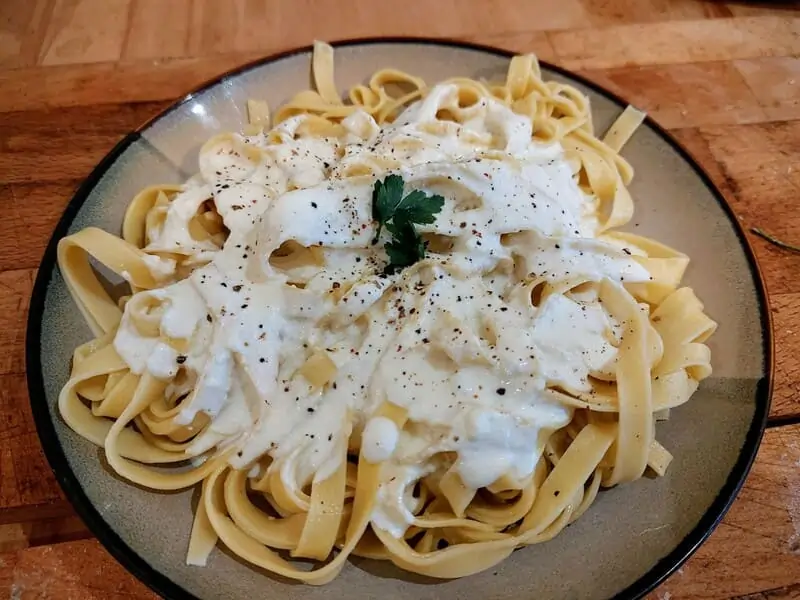What is Carbonara sauce made of has been asked by many people and in this article you will understand it easy. Carbonara sauce is one of Italy’s most iconic culinary creations, celebrated for its rich and silky texture. This sauce, rooted in Roman traditions, uses a few high-quality ingredients to create a dish that’s simple yet elegant. In this article, we’ll explore what Carbonara sauce is made of, its origins, and how to master its preparation.
The Origins of Carbonara Sauce
The history of Carbonara sauce is a topic of much debate among food historians. It’s widely believed to have originated in Rome, with its name derived from “carbonaro,” meaning charcoal burner. Some say it was a meal for Italian shepherds, while others argue it became popular after World War II when American soldiers introduced bacon and eggs to Italian cooks.
For an insightful comparison of Carbonara and Alfredo dishes, explore what’s the difference between Fettuccine Alfredo and Carbonara.
Ingredients of Carbonara Sauce
Core Ingredients The magic of Carbonara lies in its simplicity. Each ingredient plays a crucial role in creating the authentic flavor and texture of this beloved dish.
- Eggs: The yolks are a critical component, used exclusively to achieve the sauce’s creamy texture. When combined with the other ingredients, they create a rich, emulsified coating for the pasta.
- Pecorino Romano or Parmesan Cheese: Both cheeses are excellent choices. Pecorino Romano offers a sharper, saltier edge, while Parmesan brings a slightly milder, but still distinctly salty and nutty, flavor to the sauce.
- Pancetta or Guanciale: These Italian cured meats lay the smoky, savory foundation of the dish. Guanciale, made from pork cheek, is traditional and provides a deeper flavor than pancetta, which is a suitable substitute if guanciale is unavailable.
- Black Pepper: Freshly cracked black pepper is essential, adding a subtle spiciness that cuts through the richness of the sauce, enhancing the overall flavor profile.
Interested in exploring further? Learn more about the classic Fettuccine Carbonara recipe and its origins.
Optional Ingredients and Modern Additions While traditionalists might prefer to stick to the basics, modern takes on Carbonara often incorporate additional ingredients for variety and accessibility.
- Cream: Sometimes added for extra richness, cream is not traditionally used in Carbonara but can be included for a silkier texture. It’s important to note that while cream adds body, it can also dilute the quintessential flavors of the classic version.
- Alternative Proteins: In regions where pancetta or guanciale is hard to come by, bacon or even turkey bacon can serve as practical alternatives, providing a similar smoky profile.
- Vegetables: Incorporating vegetables like peas or sliced mushrooms can add a fresh, earthy dimension to the dish, making it a more well-rounded meal. These additions bring color and additional nutrients, appealing to those looking to include more vegetables in their meals.
For those curious about how these adaptations influence the traditional dish, or seeking to experiment with their own variations, explore our guide on modernizing classic Italian recipes.
Common Mistakes to Avoid in Carbonara Preparation

Creating the perfect Carbonara can be a rewarding culinary experience, yet certain missteps can compromise the dish’s quality. Here are some of the most common mistakes and how to avoid them to ensure your Carbonara is delicious every time.
Overcooking the Eggs
One of the trickiest aspects of making Carbonara is incorporating the eggs into the sauce without scrambling them. This mistake occurs if the eggs are added to the pasta while the pan is still on a high heat. To avoid this, it’s crucial to remove the pan from the heat before mixing in the egg and cheese mixture. Stir quickly and continuously to use the residual heat from the pasta to cook the eggs gently, achieving a creamy sauce rather than a clumpy, scrambled mess.
Watery Sauce
A common pitfall in preparing Carbonara is ending up with a sauce that is too thin and watery. This usually happens when too much pasta water is added to the egg mixture. To prevent this, add the pasta water gradually, just a tablespoon at a time, while stirring the sauce. You can always add more if needed, but it’s impossible to remove excess liquid once it’s in. The goal is to reach a consistency that beautifully coats the pasta without pooling at the bottom of the pan.
Low-Quality Ingredients
The simplicity of Carbonara means there’s nowhere to hide when it comes to ingredient quality. Using substandard cheese or meats can significantly affect the overall taste of the dish. To ensure high quality, opt for authentic Pecorino Romano or a good Parmesan cheese, and use pancetta or guanciale instead of regular bacon. These ingredients offer the salty, sharp, and savory notes essential to Carbonara’s classic flavor profile.
For those looking to delve deeper into perfecting this dish and understanding the importance of each ingredient, explore our detailed article on selecting the best ingredients for Italian cooking.
Variations and Adaptations of Carbonara
The versatility of Carbonara has inspired countless variations around the world, reflecting local ingredients, culinary creativity, and regional preferences. While the traditional Roman recipe remains the gold standard, these adaptations showcase the dish’s evolution and widespread appeal.
Regional Variations in Italy
Different regions in Italy have put their unique spin on Carbonara, often incorporating local ingredients or alternative methods while preserving the essence of the dish.
- Cheese Substitutions: In some parts of Italy, particularly in the northern regions, Grana Padano is used instead of Pecorino Romano. Grana Padano offers a milder and less salty flavor, which can appeal to those who find Pecorino too sharp. This substitution slightly softens the dish’s flavor profile while maintaining its creamy texture.
- Alternative Pasta Choices: While spaghetti is the most commonly used pasta for Carbonara, regions like Lazio and Campania may opt for bucatini, a thicker pasta with a hollow center. Bucatini’s sturdy structure pairs well with the rich sauce, ensuring every bite is flavorful. Other options like rigatoni or penne are also occasionally used, adding variety in texture and presentation. Learn about the best pasta types for different sauces.
- Cured Meat Varieties: In regions where guanciale or pancetta is less accessible, chefs may use other cured meats like speck or prosciutto. These alternatives bring their own distinctive flavors while still adhering to the spirit of the dish.
International Adaptations
Carbonara has also been reimagined in kitchens across the globe, often incorporating ingredients and techniques unique to local cuisines.
- American Carbonara: A popular version in the United States includes heavy cream in the sauce, resulting in a richer and heavier dish. This adaptation has become common in many Italian-American restaurants, though it deviates from the traditional Roman recipe.
- Asian Influences: In Japan, Carbonara often features the addition of seafood such as shrimp or squid, along with a touch of soy sauce or miso for umami depth. This fusion creates a unique blend of Italian and Japanese flavors. Explore the art of fusing Italian recipes with Asian influences.
- Vegetarian Variations: For those who prefer a meatless version, mushrooms are a popular substitute for pancetta or guanciale. Their earthy flavor and meaty texture mimic the savory richness of cured meats, making them an excellent alternative.
Experimenting at Home
Carbonara’s adaptability makes it an ideal dish for experimentation. Whether you want to try different cheeses, swap out the pasta, or explore plant-based alternatives, there’s no shortage of ways to make this classic dish your own. Discover more tips on creating personalized pasta dishes.
Modern Twists on Carbonara

Over the years, chefs and home cooks worldwide have embraced Carbonara’s versatility, creating innovative variations that cater to different dietary needs, flavor preferences, and health-conscious lifestyles. Here’s how this classic dish has been reimagined to suit modern tastes.
Vegetarian Carbonara
For those who avoid meat but still crave the creamy indulgence of Carbonara, vegetarian options offer a delightful alternative without compromising on flavor.
- Mushrooms: Meaty, umami-rich mushrooms, such as portobello or shiitake, are often used to replace pancetta or guanciale. Sautéed with garlic and olive oil, they bring a savory depth that complements the creaminess of the sauce.
- Zucchini: Thinly sliced or diced zucchini can provide a lighter, fresh alternative. Its mild flavor allows the cheese and pepper to shine while adding a touch of color to the dish.
Vegetarian adaptations maintain the essence of Carbonara while opening the dish to a wider audience. Explore more vegetarian pasta recipes for creative inspiration.
Vegan Carbonara
Vegan Carbonara takes the transformation a step further, swapping out all animal-based ingredients for plant-based substitutes.
- Cashew Cream: A blend of soaked cashews and water creates a creamy, rich base that mimics the texture of the traditional egg-and-cheese sauce.
- Nutritional Yeast: This ingredient delivers a cheesy flavor without dairy and is often paired with cashew cream to replicate the umami richness of Pecorino Romano or Parmesan.
- Smoked Tofu or Coconut Bacon: To replicate the savory, smoky flavor of pancetta, many vegan recipes incorporate smoked tofu, tempeh, or coconut bacon.
Learn how to make vegan-friendly Italian dishes at home.
Healthier Options
For those who love Carbonara but are looking for lighter versions, healthier adaptations provide a guilt-free way to enjoy this beloved dish.
- Lean Proteins: Replace traditional pancetta or guanciale with turkey bacon or lean pancetta. These alternatives lower the fat content while still contributing a smoky, savory element to the sauce.
- Low-Carb Substitutions: Zucchini noodles, or “zoodles,” are a popular choice for those following low-carb or gluten-free diets. Spiralized zucchini provides the satisfying texture of pasta with a fraction of the calories and carbs.
- Reduced Cheese: Cutting back on the amount of cheese or using lighter options can make a noticeable difference in the dish’s calorie count while still delivering its signature creaminess.
These healthier variations are perfect for those aiming to balance indulgence with mindful eating. Discover more ways to enjoy Italian classics with a healthy twist.
Frequently Asked Questions
What makes Carbonara sauce creamy without cream?
The creaminess comes from emulsifying egg yolks, cheese, and pasta water. This combination creates a silky texture without the need for cream. For tips on achieving the perfect consistency, explore this guide on how to make Fettuccine Carbonara.
Can I use bacon instead of pancetta or guanciale?
Yes! Bacon is a common substitute, though guanciale offers a more authentic, rich flavor.
Why does my sauce turn into scrambled eggs?
Scrambled eggs result from high heat during mixing. Always combine ingredients off the heat for a smooth sauce. For troubleshooting tips, see this step-by-step guide on how to avoid Carbonara mistakes.
What’s the best cheese for Carbonara?
Pecorino Romano is traditional, but Parmesan is an acceptable alternative. For ideas on using cheese in other Italian recipes, explore this article on Italian pasta classics.
Can I make Carbonara without eggs?
Vegan versions use cashew cream or silken tofu as a replacement for eggs to mimic the creamy texture. If you’re curious about other creative adaptations, read this guide on modern twists on Carbonara.
Conclusion
Carbonara sauce is more than just a recipe; it’s a testament to the elegance of simplicity in Italian cooking. With just a handful of fresh, high-quality ingredients, you can create a dish that’s comforting and gourmet. Whether you stick to tradition or experiment with modern twists, mastering Carbonara is a rewarding culinary journey.
For another Italian favorite, explore this guide on perfecting lasagna recipes.

